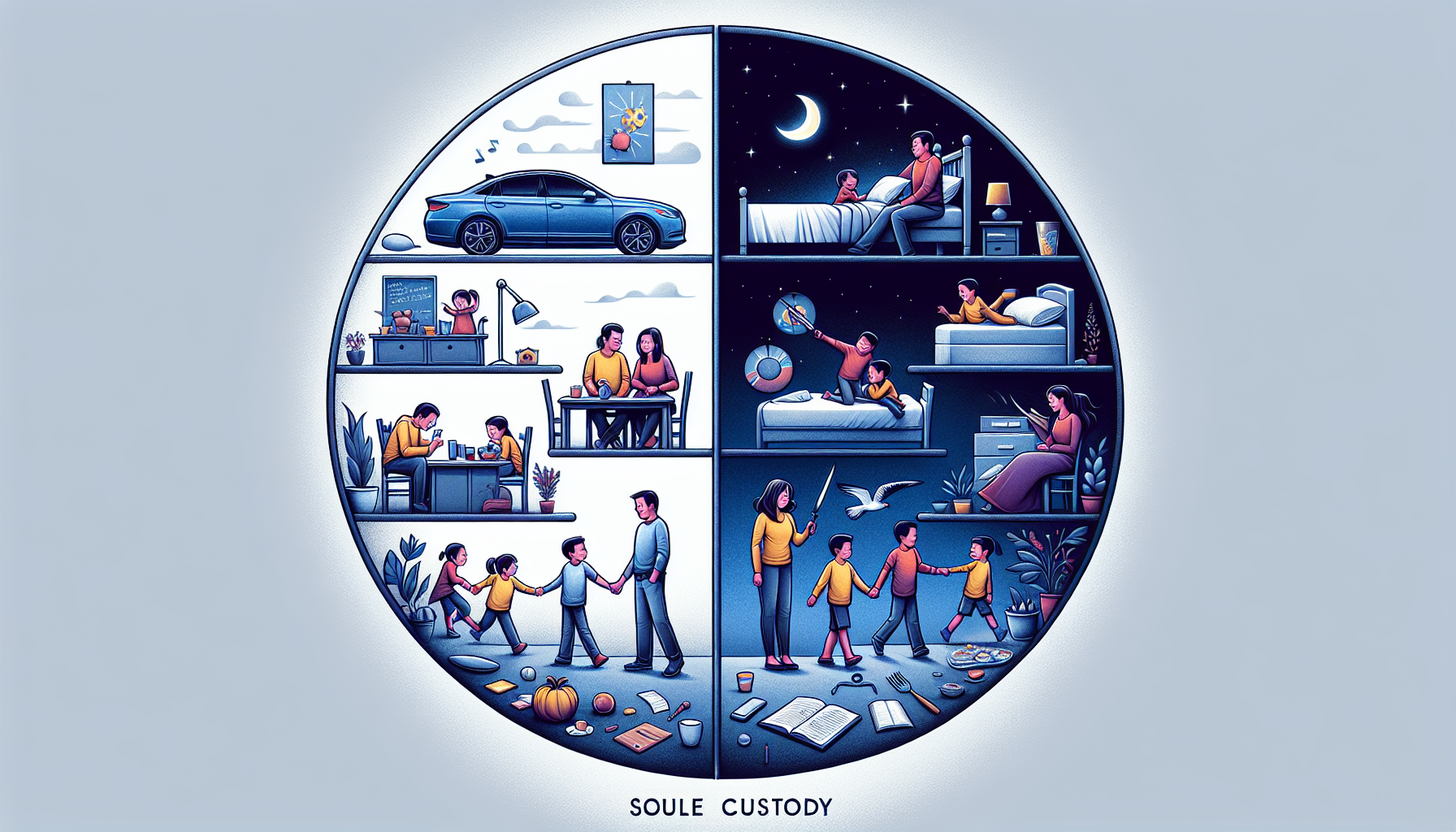Divorce or separation brings to the forefront critical legal decisions regarding your children. Among the most significant are the distinctions between legal custody and physical custody. Legal custody pertains to a parent’s authority to make important life decisions for a child, while physical custody involves where and with whom the child will reside. This article delves into the difference between legal custody and physical custody, shaping your insight into how each one impacts your rights as a parent and the best interests of your child.
Key Takeaways
Legal custody refers to the authority to make significant decisions in a child’s life, while physical custody indicates with whom the child lives. Both types can be assigned as either ‘joint’ (shared between parents) or ‘sole’ (allocated to one parent).
The court considers various factors in custody decisions, including the role of the primary caretaker, child’s preference, and each parent’s capability to care for the child, while prioritizing the child’s best interest and well-being.
Parenting plans are essential documents in child custody that outline care, living arrangements, and visitation schedules; flexibility and effective dispute resolution are vital in co-parenting. Custody arrangements can be modified if circumstances change and it serves the child’s best interest.
Defining Legal and Physical Custody
When we talk about child custody, we are essentially referring to two distinct types: legal custody and physical custody. Legal custody refers to a parent being granted the authority to make significant decisions regarding the child’s welfare. It encompasses areas such as healthcare, education, and even religious upbringing. On the other hand, physical custody deals with the child’s living arrangements, determining which parent the child lives with most of the time.
Keep in mind that the ultimate goal of determining custody is to serve the best interests of the child. The specifics of legal and physical custody can vary based on individual circumstances and the court’s judgment. Whether you’re newly becoming divorced parents or revisiting an old custody case, understanding these forms of custody is key to ensuring your child’s well-being.
Legal Custody: Decision-Making Authority
Legal custody is like the steering wheel in the vehicle of your child’s life. It gives you the authority to make significant decisions that shape their future. This includes decisions about their schooling, religious activities, and their medical treatment and care. In cases of joint legal custody, both parents share this responsibility, fostering a collaborative approach to parenting. Conversely, in cases of sole legal custody, one parent holds this decision-making authority.
Having this decision-making power comes with great responsibility. The choices you make under your legal custody, whether it’s about your child’s education or healthcare, can have profound effects on their life. Therefore, it’s vital to make these decisions wisely, always keeping your child’s best interests at heart.
Physical Custody: Daily Care and Living Arrangements
If legal custody is the steering wheel, think of physical custody as the vehicle itself. Physical custody refers to where your child lives and who provides their daily care. In the case of sole physical custody, the child primarily resides with one parent, while the other parent may have visitation rights. On the other hand, joint physical custody implies that the child divides their time between both parents’ homes. Understanding the difference between physical and legal custody is crucial for parents navigating the complexities of child custody arrangements.
The challenge with physical custody, particularly in joint arrangements, is maintaining consistency for the child. This means:
Establishing similar rules and schedules in both parents’ households
Creating a stable and consistent environment for the child’s well-being
Achieving a balance that is vital for successful joint custody.
Types of Legal and Physical Custody

Having understood what legal and physical custody entails, it’s important to know that these forms of custody can be categorized further into joint or sole custody. In a nutshell, joint custody allows both parents to share responsibilities and rights regarding their children, facilitating cooperative parenting. On the other hand, sole custody assigns all responsibilities and rights to one parent, usually due to the other parent’s inability to provide for the child’s needs, or if it’s in the child’s best interest.
These types of custody arrangements are not a one-size-fits-all. They are as unique as the families they serve. Each arrangement carries its own set of challenges and benefits, and understanding them is crucial in navigating your custody case. Let’s delve deeper into what joint and sole legal and physical custody mean and their implications.
Joint Legal and Physical Custody
Joint custody is like a joint venture, where both the parents share custody and the rights and responsibilities of raising their child. Under joint physical custody, children divide their time between both parents’ homes. This arrangement promotes the child’s meaningful relationship with both parents, which is often regarded as being in their best interest. In fact, some states start with the presumption that joint physical custody is in the best interest of the children.
The concept of sharing extends beyond living arrangements to the decision making process of-making as well. Joint legal custody means that parents share the right and responsibility to make significant decisions about their children’s lives. When parents are awarded joint legal custody, it encourages cooperative parenting and decision-making, which is crucial for the child’s overall well-being. This includes decisions about education and health matters.
Sole Legal and Physical Custody
On the other end of the spectrum is sole custody, where one parent is granted primary custody with the full spectrum of responsibilities and rights. Under sole legal custody, only one parent has the right and responsibility to make significant decisions for the children. Sole physical custody means that the children primarily live with one parent. This arrangement involves the children spending the majority of their time with one parent..
While this arrangement might seem limiting, it’s often necessary for the child’s best interest. For instance, in cases of domestic violence where one parent is absent or incapable. However, the non-custodial parent isn’t completely sidelined. They may have visitation rights, and the specifics of these can vary greatly, ranging from liberal to restricted visitation rights, depending on the circumstances.
Factors Influencing Custody Decisions
Determining custody isn’t a random process. It’s a careful consideration of various factors, all aimed at safeguarding the best interests of the child. The court’s primary goal is to ensure that the child’s welfare is prioritized, and this forms the basis for their custody decisions.
One critical factor considered is who the primary caregiver was during the marriage. This is especially important when determining primary physical custody. Alongside this, the child’s preference is also considered, albeit with the understanding that the final decision lies with the court.
Let’s explore these factors in more detail.
Primary Caretaker
The role of the primary custodial parent, often referred to as the primary caretaker, holds significant weight in custody decisions. Given the importance of stability and consistency in a child’s life, courts often favor the parent who has been the primary caretaker. This individual typically undertakes responsibilities such as:
feeding, clothing, and bathing the child
attending school meetings and extracurricular activities
going to medical appointments
planning leisure activities
assisting with homework
However, being the primary caretaker of minor child extends beyond these day-to-day activities. It also involves the emotional investment and involvement in the child’s everyday life. This includes attending events and providing day-to-day caregiving. A parent’s involvement in their child’s life is a critical factor in determining custody outcomes.
Child’s Preference
Every child is unique, and their voice matters in custody decisions. Courts take into consideration a child’s wishes regarding custody and visitation when they display sufficient maturity. The weight given to a child’s preference is significantly influenced by their maturity and ability to articulate a reasoned choice.
For instance, in California, the preferences of children over 14 years of age are given greater consideration in custody decisions. However, it’s important to remember that the child’s preference is just one aspect that courts evaluate. It’s considered alongside other factors to determine the child’s best interests.
Other Considerations
Beyond the primary caretaker and the child’s preference, courts consider several other factors to determine custody. Some of these factors include:
Financial resources and the capacity of each parent to meet the child’s needs
The stability and security of each parent’s home environment
The mental and emotional well-being of the child
The ability of the parents to effectively co-parent
Maintaining connections to the child’s home, school, and community
These factors aim to ensure a stable and secure environment for the child, prioritize their well-being, and positively impact the child’s life.
Some issues may complicate custody decisions. These major issues include:
Family violence
Mental and physical health issues
Substance abuse
Parental alienation
These factors are critically evaluated, with the priority of addressing any history of abuse to ensure the child’s well-being. Changes in custody agreements may be made to better support the child’s relationships with both parents.
Creating a Parenting Plan
A parenting plan is like a roadmap for your child’s journey through the custody landscape. It’s a comprehensive document that outlines childcare, living arrangements, and visitation schedules, all while prioritizing the child’s best interests. A well-structured parenting plan can serve as an invaluable tool in navigating the complexities of child custody, whether you’re dealing with joint or sole custody.
The plan should detail custody preferences, describe specific care arrangements for the children, outline their living situations, and provide a complete schedule for parenting time. This includes:
school days
weekends
holidays
vacations
special events
Parents can formalize their parenting plan by completing specific legal forms, which both the child’s mother or her parents must sign to validate the arrangement.
To make the parenting plan a legally binding court order, parents must obtain a judge’s signature and pay a filing fee after drafting their agreement.
Co-Parenting Communication
Navigating co-parenting demands a high level of communication. It requires parents to prioritize their child’s needs above personal feelings to ensure a mature co-parenting environment. Approaching the co-parenting relationship with respect, akin to a business partnership, helps focus on the child’s well-being. Agreeing on major decisions related to the child’s healthcare, education, and financial issues is essential and requires clear communication between co-parents.
However, disagreements are inevitable. The key is to resolve these disputes respectfully and amicably, keeping the child’s best interests at heart. Documenting co-parenting decisions is a practical step to handle routine and unforeseen circumstances effectively. This helps prevent miscommunication and ensures that all decisions are made in the best interest of the child.
Scheduling and Flexibility
Flexibility is the name of the game in co-parenting. Parents should aim to be flexible with one another, adapting to each other’s schedules and being considerate about the time each parent and child spends together with the child. Parenting time can be:
formally scheduled
reasonably open-ended
supervised
disallowed (in certain cases concerning the child’s safety)
In addition, the geographical distance between each parent’s home should be evaluated. The proximity or distance can significantly impact the child’s routine and their relationship with both parents. A well-thought-out parenting plan that includes flexible scheduling can alleviate many of these potential issues.
Resolving Disputes
Disputes are a common occurrence in co-parenting. However, the way these disputes are handled can make all the difference. Direct communication between co-parents and protecting children from custody conflicts are critical for resolving disputes. A mature approach to conflict resolution can ensure that disputes are resolved in a way that prioritizes the child’s welfare.
In some cases, disagreements in joint legal custody can escalate to frequent legal conflicts. When this happens, court intervention may be necessary to resolve ongoing disputes. It’s important to keep in mind that the court’s primary concern is the child’s best interests, and any decision made will reflect this priority.
Modifying Custody Arrangements
Life is full of changes, and custody arrangements are no exception. There may be instances where modifying a custody order becomes necessary. These could range from a parent’s relocation to alterations in a parent’s work schedule that conflict with current custody arrangements. In such cases, a parent must file a motion or ‘Request for Order’ and provide a compelling declaration outlining the reasons for the request.
Parents can also modify a custody arrangement through mutual agreement, leading to a stipulation signed by a family court judge. Mediation can also be an effective method to negotiate changes to child custody orders, especially if the parents have a history of successful collaboration on custody terms.
Ultimately, the process of modifying custody arrangements must prioritize the best interests of the child and ensure their well-being.
Summary
Navigating the world of child custody can be a complex task. However, understanding the intricate details of legal and physical custody, along with the different types of custody arrangements, can make this journey easier. Whether it’s joint or sole custody, knowing what each entails can help you make informed decisions that serve your child’s best interest.
Remember, at the heart of every custody decision is the child’s welfare. Whether you’re creating a parenting plan share joint legal custody, resolving disputes, or modifying custody arrangements, always keep your child’s best interests in mind. With mutual respect, clear communication, and a child-centered approach, you can navigate the complexities of child custody and ensure your child’s well-being.
Frequently Asked Questions
What is the meaning of legal and physical custody?
Legal custody refers to the authority to make important decisions for the children, such as healthcare and education, while physical custody pertains to where the children primarily live. These two types encompass the rights and responsibilities of parents in child and custody cases.
What does joint custody involve?
Joint custody involves shared decision-making and living arrangements for the child, with the child splitting their time between both parents’ homes.
How does the court decide on custody arrangements?
The court decides on custody arrangements by considering several factors, such as the child’s primary caretaker, the child’s preference, and other relevant factors like financial resources and emotional well-being. It may also take into account any history of abuse or parental alienation.
What is a parenting plan?
A parenting plan is a detailed document that covers childcare, living arrangements, and visitation schedules, focusing on the child’s well-being.
Can custody arrangements be modified?
Yes, custody arrangements can be modified through mutual agreement, mediation, or court intervention, depending on the circumstances and reasons for the change. There are various avenues available for modifying custody arrangements based on individual circumstances.


